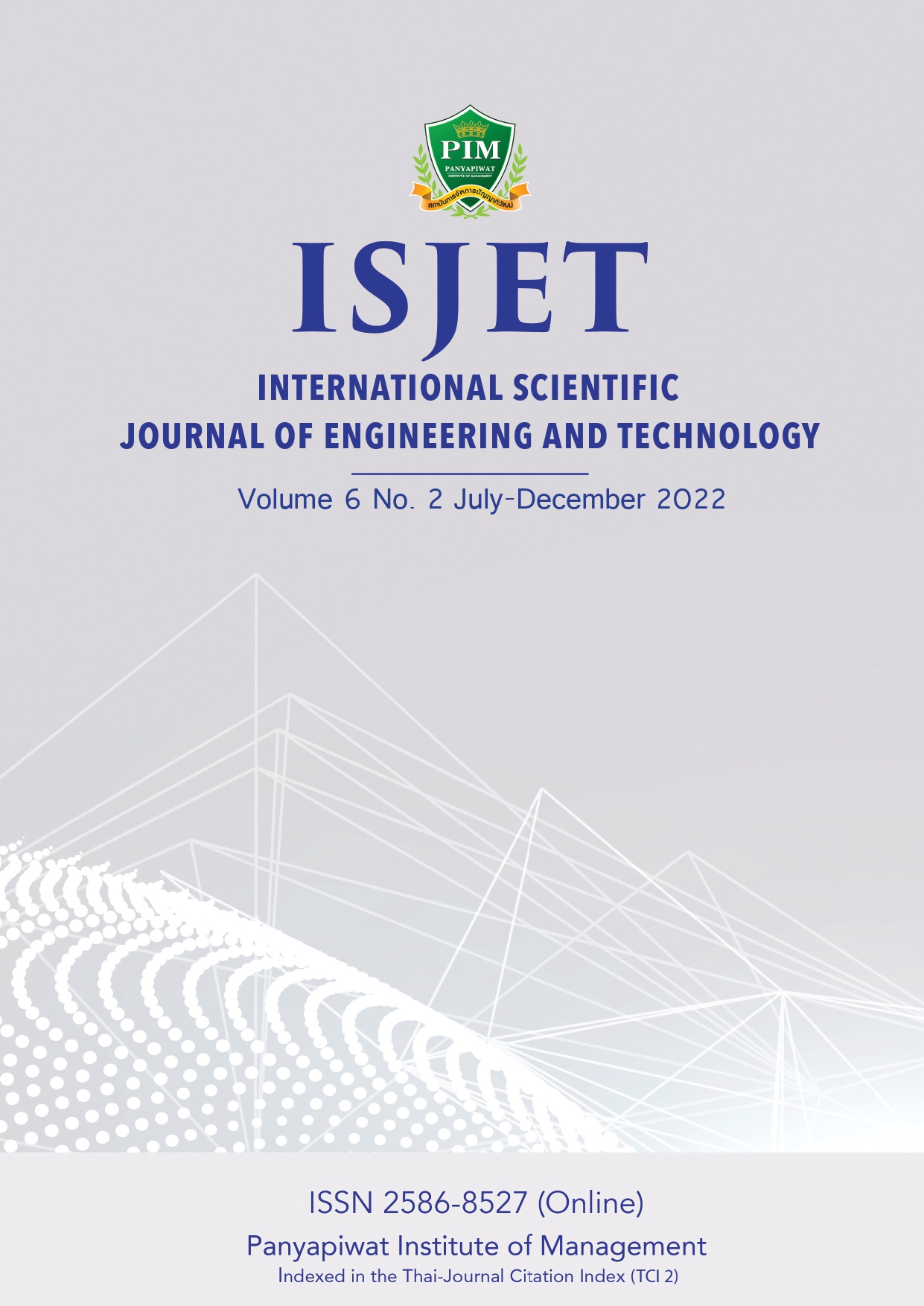Identifying ATM Fraud Transactions in Thailand using Location-based Grouping and Behavior Feature
Main Article Content
Abstract
Financial fraud causes a major loss to a bank. The challenge of classifying fraud is a high true positive rate while keeping the number of false positives as low as possible. One difficulty is the unbalanced size of the labeled data that causes a low detection rate and a high false-positive rate. We present a method to sample the data to cope with the unbalance problem in the fraud detection problem. The location feature is applied to separate accounts into ‘local-only’ and ‘has-abroad’. The proposed feature extraction can separate many fraud transactions from legitimate transactions. To differentiate the fraud from the legitimate transactions, the fraud can be considered as an outlier. Transformation functions, the deviation, the risk, and the probability features are applied in this work to both numeric and non-numeric features. The experimental result shows that the location-based separation together with the proposed features achieves higher TRP and lower FPR than not dividing the group. It achieves a true positive rate of 75.00% for ‘local-only’ and 100% for ‘has-abroad’. The lowest false positive rate is 8.23% for ‘has-abroad’. Comparing the efficiency of the proposed features, the true positive rate is improved from 56.25% to 75.00%.
Article Details

This work is licensed under a Creative Commons Attribution-NonCommercial-NoDerivatives 4.0 International License.
เนื้อหาข้อมูล
References
Ben Knieff, “2016 Flobal Custumer Card Fraud: Where Card Fraud is Coming From,” Aite Group LLC., Boston, USA, Jul. 2016.
T. Guo and G.-Y. Li, “Neural Data Mining for Credit Card Fraud Detection,” in Proc. 2008 International Conference on Machine Learning and Cybernetics, 2008, pp. 3630-3634.
C. Whitrow, D. J. Hand, P. Juszczak et al., “Transaction Aggregation as a Strategy for Credit Card Fraud Detection,” Data Mining and Knowledge Discovery, vol. 18, no. 1, pp. 30-55, Feb. 2009.
M. Krivko, “A Hybrid Model for Plastic Card Fraud Detection Systems,” Expert Systems with Applications, vol. 37, no. 8, pp. 6070-6076, Aug. 2010.
J. R. Dorronsoro, F. Ginel, C. Sgnchez et al., “Neural Fraud Detection in Credit Card Operations,” IEEE Transactions on Neural Networks, vol. 8, no. 4, pp. 827-834, Jul. 1997.
E. Aleskerov, B. Freisleben, and B. Rao, “Cardwatch: A Neural Network Based Database Mining System for Credit Card Fraud Detection,” in Proc. The IEEE/IAFE 1997 Computational Intelligence for Financial Engineering, 1997, pp. 220-226.
K. K. Sherly and R. Nedunchezhian, “Boat Adaptive Credit Card Fraud Detection System,” in Proc. 2010 IEEE International Conference on Computational Intelligence and Computing Research, 2010, pp. 1-7.
J. Gehrke, V. Ganti, R. Ramakrishnan et al., “Boat— Optimistic Decision Tree Construction,” SIGMOD Rec., vol. 28, no. 2, pp. 169-180, Jun. 1999.
E. Kirkos, C. Spathis, and Y. Manolopoulos, “Data Mining Techniques for the Detection of Fraudulent Financial Statements,” Expert Systems with Applications, vol. 32, no. 4, pp. 995-1003, May. 2007.
E. Ngai, Y. Hu, Y. Wong et al., “The application of Data Mining Techniques in Financial Fraud Detection: A Classification Framework and An Academic Review of Literature,” Decision Support Systems, vol. 50, no. 3, pp.
-569, Feb. 2011.
S. X. Wu and W. Banzhaf, “Combatting Financial Fraud: A Coevolutionary Anomaly Detection Approach,” in Proc. The 10th Annual Conference on Genetic and Evolutionary Computation, SER. GECCO ’08, 2008, pp. 1673-1680.
D. Huang, D. Mu, L. Yang et al., “Codetect: Financial Fraud Detection with Anomaly Feature Detection,” IEEE Access, vol. 6, pp. 19161-19174, Mar. 2018.
K. Yamanishi, J. I. Takeuchi, G. Williams et al., “On-Line Unsupervised Outlier Detection Using Finite Mixtures with Discounting Learning Algorithms,” Data Mining and Knowledge Discovery, vol. 8, no. 3, pp. 275-300, May. 2004.
V. Chandola, A. Banerjee, and V. Kumar, “Anomaly Detection: A Survey,” ACM Comput. Surv., vol. 41, no. 3, pp. 15:1-15:58, Jul. 2009.
MIT. (2018, Oct. 2). Reducing False Positives in Credit Card Fraud Detection. [Online]. Available: https://www. sciencedaily.com/releases/2018
/09/180920131513.htm
D. J. Hand and V. Vinciotti, “Choosing K for Two-Class Nearest Neighbour Classifiers with Unbalanced Classes,” Pattern Recognition Letters, vol. 24, no. 9, pp. 1555-1562, 2003.
S. Bhattacharyya, S. Jha, K. Tharakunnel et al., “Data mining for Credit Card Fraud: A Comparative Study,” Decision Support Systems, vol. 50, no. 3, pp. 602-613, Feb. 2011.
S. Branka, J. B. K. Hofer-Schmitz, K. Nahrgang et al., “Follow the Trail: Machine Learning for Fraud Detection in Fintech Applications,” Sensors, vol. 21, no. 5, pp. 1594, Feb. 2021.
T. Pourhabibi, K. L. Ongb, B. H. Kama et al., “Fraud Detection: A Systematic Literature Review of Graph-Based Anomaly Detection Approaches,” Decis. Support System, vol. 133, pp. 113303, Jun. 2020.
W. Bao, J. Yue, and Y. Rao, “A Deep Learning Framework for Financial Time Series Using Stacked Autoencoders and Long-Short Term Memory,” PLoS ONE, vol. 12, pp. e0180944, Jul. 2017.
A. Singh, “Anomaly Detection for Temporal Data Using Long Short-Term Memory (LSTM),” IFAC-Papers Online vol. 52, pp. 2408-2412, Jan. 2017.
C. R. Chawla, “Deep Learning for Anomaly Detection: A Survey,” arXiv:1901.03407, Jan. 2019.
A. I. Marques, V. Garcıa, and J. S. Sanchez, “On the Suitability of´ Resampling Techniques for the Class Imbalance Problem in Credit Scoring,” Journal of the Operational Research Society, vol. 64, no. 7, pp. 1060-1070, Jul. 2013.
R. Laimek and N. Kaothanthong, “Atm Fraud Detection Using Outlier Detection,” in Proc. IDEAL, 2018, pp. 539-547.
N. V. Chawla, K. W. Bowyer, L. O. Hall et al., “Smote: Synthetic Minority Over-Sampling Technique,” Journal of Artificial Intelligence Research, vol. 16, pp. 321-357, Jun. 2002.
F. T. Liu, K. M. Ting, and Z.-H. Zhou, “Isolation-Based Anomaly Detection,” ACM Trans. Knowl. Discov. Data, vol. 6, no. 1, pp. 3:1-3:39, Mar. 2012.
M. M. Breunig, H. P. Kriegel, R. T. Ng et al., “Lof: Identifying Density-Based Local Outliers,” SIGMOD Rec., vol. 29, no. 2, pp. 93-104, May. 2000.
M. Elahi, K. Li, W. Nisar, X. Lv et al., “Detection of Local Outlier Over Dynamic Data Streams Using Efficient Partitioning Method,” in Proc. 2009 WRI World Congress on Computer Science and Information Engineering, 2009, pp. 76-81.


